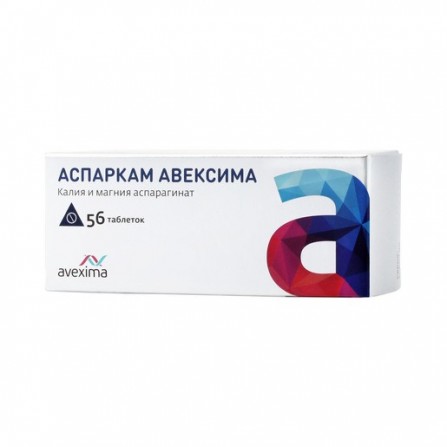More info
Active ingredients
Potassium and magnesium asparaginate
Release form
Pills
Composition
Potassium asparaginate hemihydrate 175 mg magnesium asparaginate tetrahydrate 175 mg adjuvants: potato starch - 88 mg, stearic acid - 5 mg, macrogol 4000 - 7 mg, silicon dioxide colloid - 50 mg.
Pharmacological effect
Pharmacodynamics ASPARKAM AVEXIMA is a source of potassium and magnesium ions, regulates metabolic processes. The mechanism of action is presumably associated with the role of asparaginate as a carrier of magnesium and potassium ions in the intracellular space and the participation of asparaginate in metabolic processes. Thus, ASPARKAM AVEXIMA eliminates electrolyte imbalance, reduces myocardial excitability and conductivity (moderate antiarrhythmic effect). PharmacokineticsIs easily absorbed when taken orally and relatively quickly excreted by the kidneys.
Indications
ASPARCAM AVEXIMA is used in the complex therapy of chronic heart failure, coronary heart disease, hypokalemia, and cardiac arrhythmias (including myocardial infarction, overdose of cardiac glycosides).
Contraindications
Hypersensitivity to the drug, violation of amino acid metabolism, acute and chronic renal failure, hyperkalemia, hypermagnemia, adrenal cortex insufficiency, impaired atrioventricular conduction (AV block I-IIIst.) Severe myasthenia .st.); age up to 18 years. With caution: pregnancy, lactation.
Precautionary measures
Application for violations of liver functionWith caution, you should prescribe the drug for violations of the liver.It is not necessary to change the dose in case of renal dysfunction. The concentration of amplodipine in the blood plasma does not depend on the degree of reduction of renal function. Use in children It is contraindicated in children and adolescents under the age of 18. Application in elderly patients With caution in elderly patients.
Use during pregnancy and lactation
Carefully.
Dosage and administration
Assign inside after eating. Adults take 1-2 pills 3 times a day. The course of treatment is 3-4 weeks.If necessary, repeat the course.
Side effects
Nausea, vomiting, diarrhea, discomfort or burning in the pancreas area (in patients with anacid gastritis or cholecystitis), atrioventricular blockade, paradoxical reaction (increase in the number of extrasystoles), hyperkalemia (nausea, vomiting, diarrhea, parastesia), and hyperemia, and hypermalemia (nausea, vomiting, diarrhea, parastesia), and may be possible. , feeling of thirst, lowering blood pressure, muscle weakness, fatigue, paresis, coma, areflexia, respiratory depression, convulsions).
Overdose
Symptoms: hyperkalemia, hypermagneemia. Treatment: IV calcium chloride, if necessary - hemodialysis and peritoneal dialysis.
Interaction with other drugs
Pharmaceuticals; joint use due to the content of potassium ions, the undesirable effects of cardiac glycosides are reduced. Due to the consumption of magnesium ions reduces the effect of neomycin, polymyxin B, tetracycline and streptomycin. It can strengthen the neuromuscular blockade caused by depolarizing muscle relaxants (atrauria besylate, decametonium bromide, suxamethonia (chloride, bromide, iodine, iodidime; Calcium reduces the effect of magnesium. Pharmacokinetic Astringents and coating agents reduce the absorption of the drug in the gastrointestinal tract (it is necessary to observe the 3-hour interval between their intake). ).
special instructions
It is necessary to control the content of potassium ions in the blood plasma. The effect on the ability to drive vehicles and other mechanisms requiring increased concentration of attention Clinical studies to assess the effect of the drug on the ability to drive vehicles and mechanisms have not been conducted.





